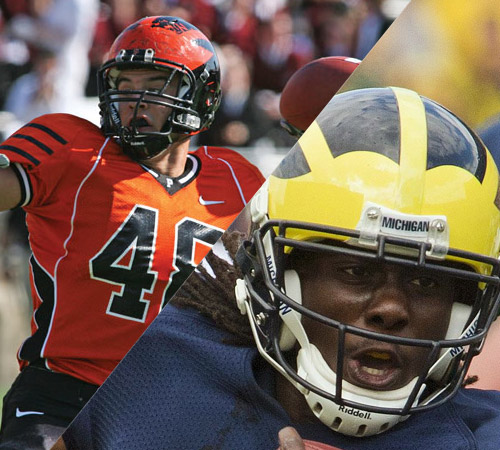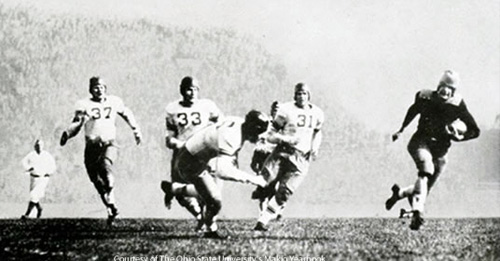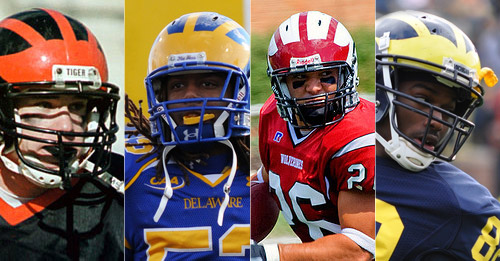Having lived in Princeton for over two years I decided it was about time to go see a Princeton Tigers' football game. With all due respect to some remarkable individual efforts including a Princeton outside linebacker, their kickoff return man, and a few Yale offensive playmakers, the game as a whole left much to be desired for someone whose football tastes were cultivated in Texas and Oklahoma.
A student of team sports uniform design, the most interesting part of the game was Princeton's winged helmet. If you have been aware of college football at any point in the last fifty years or so you will doubtlessly know of Michigan's famous winged helmet. I asked one of the Tigers' old guard seated behind me who had it first, and he assured me it was his alma mater.
Princeton
Not that I didn't trust the homer sitting behind me, but this merited some research. Here is the story according to Princeton.edu:
"Princeton's orange and black "Tiger Helmet" is a distinctive piece of the University's sports tradition. Designed by legendary Hall of Fame coach Herbert O. "Fritz" Crisler and first worn by the undefeated national championship team of 1935, this colorful headgear is a link to one of the great eras in the heralded football history of Old Nassau.
"The helmet was styled to represent a fighting tiger with its ears glared back and three symbolic orange-stripes running sleekly from front to back and matches the traditional tiger striping on the jersey. At a time when all helmets were similar, Coach Crisler thought that this highly visible emblem would help quarterbacks more readily find their downfield receivers.
"When Crisler left Princeton in 1938, he took the helmet design with him to Michigan, where in maize and blue it became an icon of that university's football program. This distinctive helmet design which originated at Princeton - where intercollegiate football was born - is a reminder to students, alumni, fans and worthy opponents of all the great Tiger players who ever proudly represented Old Nassau on the gridiron." -Princeton.edu
Surprisingly, Michigan's website supports this narrative:
Michigan
"The famous "winged" design dates from 1938 when Coach Herbert O. "Fritz" Crisler arrived from Princeton to begin a new era in Michigan football. Even as the design and composition of helmets evolved from stitched cowhide to high-tech, molded plastic, the winged design has remained the pre-eminent symbol of Michigan football.
"The distinctive helmet would also have practical advantages on the field. Crisler figured the helmet would help his halfbacks find receivers downfield. 'There was a tendency to use different colored helmets just for receivers in those days, but I always thought that would be as helpful for the defense as for the offense,' Crisler recalled." - Bentley Historical Library
Here is an interesting video about the Michigan helmet reconditioning process. Although it is heavily pro-Michigan, the fact remains that their helmet is certainly the most recognizable in the college sports landscape.
However! As it turns out, there is more to this story. Ohio State University claims to have used a "winged" design as early as 1930:
Ohio State
"On September 11, 1930, Ohio State Head Coach Sam Willaman had his Buckeyes debut new uniforms along with winged helmets at Northwestern. This was the first time any team, either college or professional, wore a winged helmet.
The first winged helmet was a dark leather helmet with a lighter contrasting color wing on the front. The wing was put in place as extra padding to help sustain collisions.
Willaman had his teams wear the winged helmet for three seasons and in 1934, new Head Coach Francis Schmidt kept the winged helmets for his first season, but opted to return to the traditional leather helmets during his second season in 1935." - SpartanJerseys.com
The reason this is not as popular a narrative, however, is due to the nature of the "wings" on the helmet. The uniqueness of the Princeton/Michigan design includes the three stripes coming out of the center front of the wings, and wrapping around the head to converge in the back. However! Photographic evidence proves that the "three striped winged helmet" had been used even prior to Crisler's 1935 Princeton team.
Indiana
"In 1933, Indiana started wearing winged helmets under Head Coach Earle "Billy" Hayes with a victory over Miami (OH) on September 30, 1933.Indiana’s winged helmet consisted of a black leather helmet with a white wing and three white stripes running from front to back. A small block “I” logo was centered on the front of the wing.
"In 1934, Indiana hired a new head coach, Alvin "Bo" McMillin, who began phasing out the winged helmets only one year after the helmets were debuted at Indiana. Photos of the team and games depict only half of Indiana’s players wearing winged helmets during this season, with the other half wearing the traditional leather helmet. This suggests the NCAA and Big Ten rules regarding consistency with helmets were more flexible in 1934.
"By 1935, the entire team switched back to traditional leather helmets ending their two-year stint wearing the winged helmets." - SpartanJerseys.com
Spalding's FH5 three striped winged helmet featured on the cover of the 1938 Spalding Official Intercollegiate Football Guide:
So as it turns out Princeton was not the first utilize to utilize either a winged helmet or the three striped winged helmet design. The Michigan State Spartans page has a more robust history on it than mine, including excellent academic sources in case you don't want to take my word on any of this.
I might buy what they have to say since Michigan State no longer uses a winged helmet design and doesn't stand to loose anything. However, with Michigan being their biggest rival, it might behoove them to discredit one of Michigan's coaches with the creation of it... conspiracy?
Although Princeton abandoned the winged helmet when Crisler left after the '37 season, the Tigers resurrected it in 1998 and use it to this day. Upon further research (read: Wikipedia) I found an abbreviated record of other schools who have used the design:
- Saint Peter's College, New Jersey (football program since dropped)
- University of Delaware
- Southwest Baptist University (stopped its use in 2008)
- Grove City College
- Gustavus Adolphus College
- Middlebury College
- Nichols College
This topic definitely merits more research than the cursory web search I've done here, but it's certainly enough to whet my appetite on the unique headgear. In case you're interested here is the Wikipedia page on the history of the winged helmet design. I won't be posting again before the new year, so enjoy your holidays and the remainder of 2011.
See you all in 2012.







